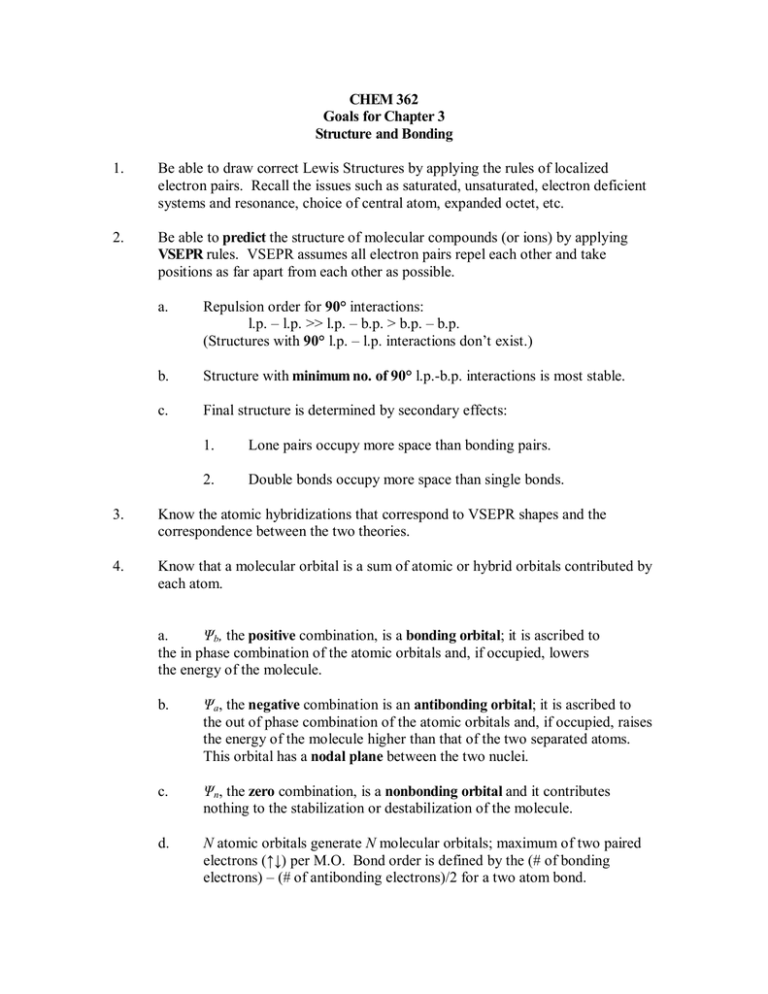CHEM 362 Goals for Chapter 3 Structure and Bonding
advertisement

CHEM 362 Goals for Chapter 3 Structure and Bonding 1. Be able to draw correct Lewis Structures by applying the rules of localized electron pairs. Recall the issues such as saturated, unsaturated, electron deficient systems and resonance, choice of central atom, expanded octet, etc. 2. Be able to predict the structure of molecular compounds (or ions) by applying VSEPR rules. VSEPR assumes all electron pairs repel each other and take positions as far apart from each other as possible. a. Repulsion order for 90° interactions: l.p. – l.p. >> l.p. – b.p. > b.p. – b.p. (Structures with 90° l.p. – l.p. interactions don’t exist.) b. Structure with minimum no. of 90° l.p.-b.p. interactions is most stable. c. Final structure is determined by secondary effects: 1. Lone pairs occupy more space than bonding pairs. 2. Double bonds occupy more space than single bonds. 3. Know the atomic hybridizations that correspond to VSEPR shapes and the correspondence between the two theories. 4. Know that a molecular orbital is a sum of atomic or hybrid orbitals contributed by each atom. a. Ψb, the positive combination, is a bonding orbital; it is ascribed to the in phase combination of the atomic orbitals and, if occupied, lowers the energy of the molecule. b. Ψa, the negative combination is an antibonding orbital; it is ascribed to the out of phase combination of the atomic orbitals and, if occupied, raises the energy of the molecule higher than that of the two separated atoms. This orbital has a nodal plane between the two nuclei. c. Ψn, the zero combination, is a nonbonding orbital and it contributes nothing to the stabilization or destabilization of the molecule. d. N atomic orbitals generate N molecular orbitals; maximum of two paired electrons (↑↓) per M.O. Bond order is defined by the (# of bonding electrons) – (# of antibonding electrons)/2 for a two atom bond. 5. Know that σ orbitals have cylindrical symmetry around the inernuclear (z) axis; π orbitals have one, and δ two, nodal planes coincident with the internuclear axis. Be able to sketch: σ orbitals: s + s, s + pz, pz + pz, s + dz2, pz + dz2 σ* orbitals: s - s, s - pz, pz - pz π orbitals: px + px, py + py, px + dxz, py + dyz, dxz + dxz, dyz + dyz π* orbitals: px - px, py - py δ orbitals: dxy + dxy, dx2-y2 + dx2 -y2 6. Know that σ overlap is stronger than π overlap which is stronger than δ overlap. 7. Know that the effective nuclear charge of an atom determines the relative energy of the valence orbitals in a M.O. diagram and that it also affects the energy separation of the s and p levels. These effects show up in the differences in the M.O. diagrams of diatomic molecules, A2, of the second row elements. (Mixing versus no mixing of the s and p overlap.) 8. Know how to sketch overlap patterns for various s and p combinations for diatomic and triatomic molecules as we did in lecture and how to sketch a qualitative M.O. diagram for these simple cases. 9. Know how the occupation of the highest energy M.O. in a molecule affects it’s reactivity (occupation of a bonding versus an antibonding level.) 10. Know that Bond Order in a simple diatomic molecule is defined as the (# of Bonding Electrons - # of Antibonding electrons)/2.






